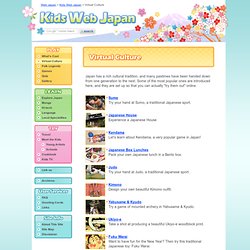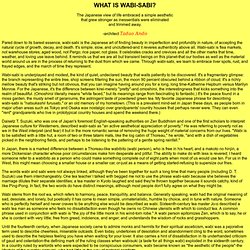

Sushi-etiquette.jpg (500×791) 319734_10150835738651213_1588852144_n-1.jpg (380×382) Japanese Culture for Kids. Learning About Japanese Culture For Kids. Families with boys hang colourful carp kites, called Koinobori, outside their houses - one for each...

Daruma dolls, or dharma dolls, are meant to help wishes come true! These roly-poly dolls are... Kokeshi are a traditional Japanese wooden doll, with simple painted face and one-piece body. The... The Samurai were the most noble warriors of Japan, and the Samurai Helmet which they wore also... Virtual Culture.
Japan has a rich cultural tradition, and many pastimes have been handed down from one generation to the next.

Some of the most popular ones are introduced here, and they are set up so that you can actually "try them out" online. SumoTry your hand at Sumo, a traditional Japanese sport. Japanese HouseExperience a Japanese House KendamaLet's learn about Kendama, a very popular game in Japan! Japanese Box LunchesPack your own Japanese lunch in a Bento box. JudoTry your hand at Judo, a traditional Japanese sport. You'll need the Flash plugin before you can start. You'll need the Shockwave plugin before you can start. What Is Wabi-Sabi? The Japanese view of life embraced a simple aesthetic that grew stronger as inessentials were eliminatedand trimmed away.

-architect Tadao Ando Pared down to its barest essence, wabi-sabi is the Japanese art of finding beauty in imperfection and profundity in nature, of accepting the natural cycle of growth, decay, and death. It's simple, slow, and uncluttered-and it reveres authenticity above all. Wabi-sabi is flea markets, not warehouse stores; aged wood, not Pergo; rice paper, not glass. It celebrates cracks and crevices and all the other marks that time, weather, and loving use leave behind. Wabi-sabi is underplayed and modest, the kind of quiet, undeclared beauty that waits patiently to be discovered.
Daisetz T. In Japan, there is a marked difference between a Thoreau-like wabibito (wabi person), who is free in his heart, and a makoto no hinjin, a more Dickensian character whose poor circumstances make him desperate and pitiful. Sabi by itself means "the bloom of time. " 9 principles of culture. There are 9 basic principles that underlie Japanese art and culture.

They're called aesthetics — concepts that answer the question: what is art? There are 9 Japanese aesthetics. They are the basis for Japanese art, fashion, pop culture, music and movies. 1. Wabi-sabi (imperfect) Can you imagine if all the characters in movies were perfect? Culture Japan - Your portal to Japan.